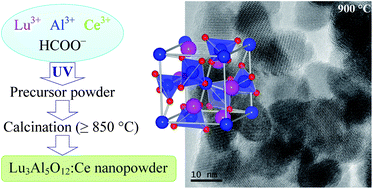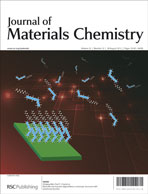Radiation-induced preparation of pure and Ce-doped lutetium aluminium garnet and its luminescent properties†
Abstract
Radiation-induced preparation of pure or doped lutetium aluminium garnet Lu3Al5O12 (LuAG) is reported as a simple and robust process, which is easy to control. Irradiation of an aqueous solution containing formate anions and soluble salts of both metal ions by ionizing radiation or UV light leads to precipitation of an amorphous solid phase. Subsequent calcination in the interval 850–1200 °C results in the crystallization of the LuAG with a well developed structure. Depending on the calcination temperature, the particle size ranges from 20 to 60 nm; the prepared LuAG nanopowder was also found to be easily compactable. The manufactured Ce-doped LuAG features intensive luminescence corresponding to Ce3+ 5d–4f transitions at 510 nm and its photoluminescence excitation spectrum comprises two Ce3+ 4f–5d1, 5d2 bands at 450 and 347 nm, respectively. The decay times of Ce3+ emission in nanopowders were substantially influenced by the nanomorphological character of the prepared material. Due to its high density, chemical stability, non-toxic character and excellent scintillation efficiency, the application of Ce-doped LuAG nanopowder in photodynamic therapy and in optical ceramics preparation is suggested.


 Please wait while we load your content...
Please wait while we load your content...